Anybody who faces the loss of hearing due to damage or infection in the ear can be recommended to use hearing aids by their doctor.
OUTLINE:-
—WHO NEEDS A HEARING AID?
—WHAT IS A HEARING AID?
—TYPES OF HEARING AID
WHO NEEDS A HEARING AID?
Our ear has 3 major parts—
- The Outer Ear,
- The Middle Ear, and
- The Inner Ear.
Any kind of damage in any of these parts can cause loss of hearing. This damage can be —-
- Physical damage (a hurt or improper usage of ear cleaning tools by us), or
- An infection due to localized bacteria or virus.
The eardrum receives incident sound waves and absorbs them, thereby allowing their entry into the middle ear.
The ossicles (incus, malleus, stapes) in the middle ear receive these sound signals, amplify them, and direct them to the inner ear.
The hair cells of the cochlea in the inner ear further amplify the sound signals and convert them into electric signals for our brain to process the information.
Therefore, prolonged damage or infection of the eardrum, ossicles/middle ear, or hair cells of the cochlea in the inner ear causes loss of hearing.
WHAT IS A HEARING AID?
A hearing aid is an engineered electronic device that helps in hearing.
It has 3 major parts:-
- Microphone- It receives sound waves, absorbs them, and converts them into electric signals. These signals are passed on to the amplifier.
- Amplifier- It amplifies the wavelength of received electric waves to a higher pitch that favors easy and better hearing.
- Speaker- It is also called a Receiver. The speaker receives these amplified electric signals and further converts them back into acoustic sound energy that can be heard by the user.
HEARING AIDS: TYPES and STYLES
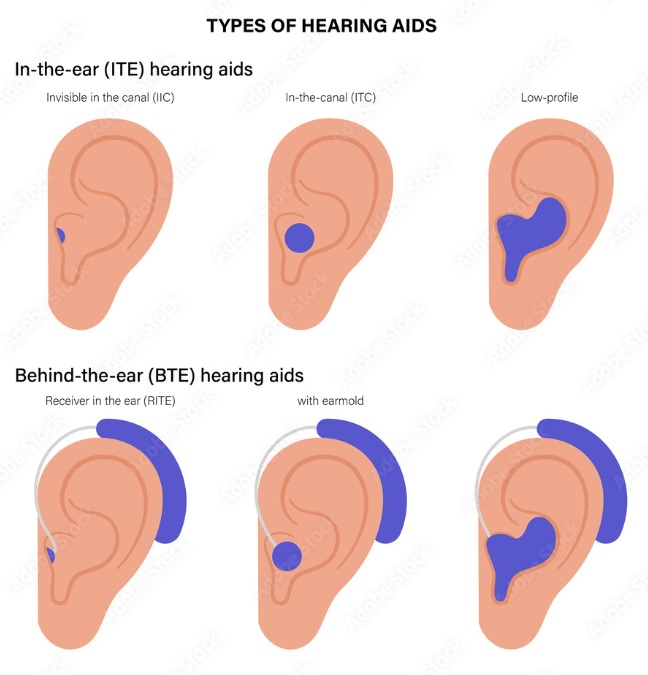
Basically, there are 2 basic types of HEARING AIDS —
(I) In-the-ear (ITE) hearing aids
The ITE hearing aids can be —-
(a) Invisible in the Canal (IIC)
(b) Completely in the canal (CIIC)
(c) In the Canal (ITC) hearing aid
(d) Low profile (Full shell or Half shell) hearing aid
(II) Behind-the-ear (BTE) hearing aids
The BTE hearing aids can be —-
(a) Receiver in the ear” (RITE) or “Receiver in canal” (RIC) type
(b) BTE with ear mould
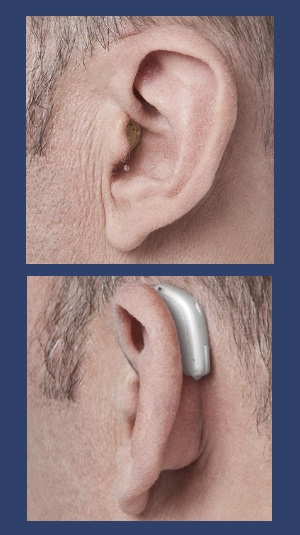
Both ITE and BTE hearing aids work on standard button battery cells that must be replaced from time to time. Nowadays, rechargeable batteries are also becoming very common.
Let’s discuss In-the-ear (ITE) hearing aids first
As the name mentions, the entire device is compressed into a small electronic system that is fitted solely in the outer ear cavity.
ITE hearing aid is called so as it is worn in the ear canal and is usually made custom-fit, based on an impression that is taken by the audiologist at the time of your hearing aid consultation. These styles are mostly custom-made according to the type of different skin tones so as to blend with the ear canal skin colour. Some types of ITE hearing aids can be fitted very deeply within the ear canal, while others ITE hearing aids are fitted less deeply in the ear canal.
IN-THE-EAR (ITE) style of Hearing aids are of the following types—-
- INVISIBLE IN THE CANAL (IIC)
- COMPLETELY IN THE CANAL (CIC)
- IN-THE-CANAL HEARING AID (ITC)
- LOW PROFILE (FULL SHELL or HALF SHELL) HEARING AID
IIC and CIC styles are the SMALLEST and most discreet hearing aids available in the market.
1. Invisible In the canal (IIC):-
This hearing aid fits deep into the ear canal with just a transparent wire visible at the outer ear opening. “Invisible in the canal” IIC styles are as described—virtually invisible. A wearer places them very deeply in the ears, and they must be removed by tugging on a small pull-out wire.
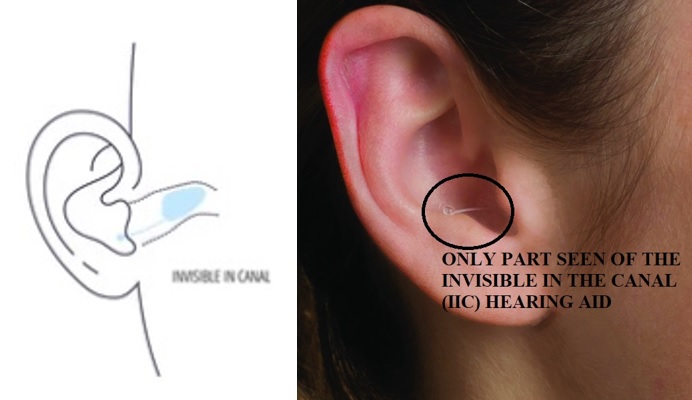
2. Completely in canal (CIC):-
Here, the device is nearly hidden inside the ear cavity. “Completely in the canal” CIC are very similar but don’t sit quite so deeply within the ears.
_200x200.jpg)
Both IIC and CIC hearing aid styles are typically fit for people with mild to moderate hearing loss. Because of their small size, they don’t usually come with any manual controls, like volume wheels or program buttons.
Advantages of IIC and CIC hearing aids:
- Very discreet
- Good sound quality because of how they fit within the ear
Disadvantages of IIC and CIC hearing aids:
- Susceptible to ear wax and moisture damage
- Small size can be a problem for dexterity
3. In-the-canal (ITC) hearing aids
ITC hearing aids sit in the lower portion of the outer ear bowl (the conchal bowl), making them relatively more comfortable and easy to use. Because they’re slightly larger in size than IIC and CIC styles, they tend to have slightly longer battery life and also have the advantage to be fitted for a wider range of hearing losses. This relatively large size also allows them to provide additional features such as directional microphones for better understanding in noisy environments and manual controls, like a volume wheel, if desired.
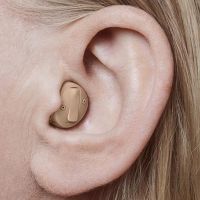
Advantages of ITC hearing aid:
- Longer battery life and more features than IIC and CIC styles
Disadvantages of ITC hearing aid:
- Susceptible to ear wax and moisture damage
- Make the wearer feel as if the ear is plugged up and gives a sensation of ear occlusion
4. Low-profile hearing aids (Full shell or Half shell)
Low profile Half shell ITE hearing aid is similar to an ITC hearing aid.
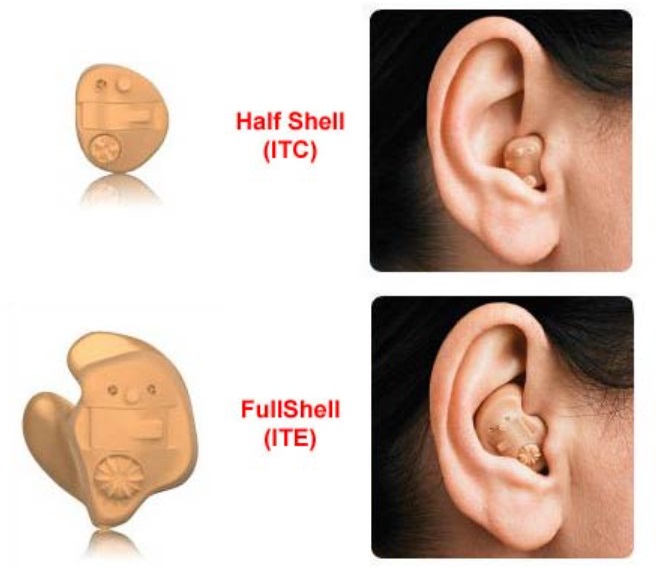
Low-profile hearing aids are almost similar to ITC hearing aid styles and range from half-shell designs that fill half the conchal bowl of the outer ear to full-shell designs that fill almost the entire conchal bowl of the outer ear.
Like the ITC style of hearing aids, the low-profile designs of hearing aids are large enough to provide additional features like directional microphones and manual controls, such as a volume wheel or a push-button for changing programs. The size of a low-profile style of hearing aid makes it desirable for people with dexterity issues because these hearing aids are easier to handle.
Advantages of Low profile ITE hearing aids:
- Larger size hence easier to insert and remove
- Accommodates more features and has more user controls
- Likely to have good connectivity to wireless devices like phones etc.
Disadvantages of Low profile ITE hearing aids:
- Less discreet than the smaller in-the-ear style of hearing aids
- Make the wearer feel as if the ear is plugged up and gives a sensation of ear occlusion
Now we will discuss a little bit about Behind-the-ear (BTE) hearing aids
A part of BTE aids sits behind or on top of the helix portion of the outer ear with tubing that channels the sound down into the ear canal via a custom-made ear mould.
This device has a plastic cork that fits into our outer ear conchal bowl and a plastic tube that runs behind our ear.
Sound is received, amplified, and converted into audible sound energy by the hearing aid which then transfers it to the inside of the ear.
It can be used by people of all age groups and helps people suffering from mild to severe hearing loss.
BTE hearing aids are of 2 types —
- “Receiver in the ear” (RITE) or “Receiver in the canal” (RIC) type
- BTE with ear mould
1. “Receiver in the ear” (RITE) or “Receiver in the canal” (RIC) type
This style is typically known as either “receiver in the ear” (RITE) or “receiver in canal” (RIC) because the speaker of the hearing aid rests in the ear canal, but the microphone and processor sit in a tiny case BEHIND THE EAR. They are connected by a thin wire.
This style of hearing aid tends to have above-average sound quality.
If it gets damaged, it is easier to repair.

Advantages of RIC/RITE hearing aid:
- Has the option of wireless connectivity to devices like phones etc
- Easy to repair
Disadvantages of RIC/RITE hearing aid:
- Smaller sizes of RITE (known as mini-RITEs) hearing aids can be a problem for dexterity
- The speaker part of the hearing aid is susceptible to moisture and ear wax damage as it is inside the ear
- The microphone and the sound processor that is placed behind the ear are visible.
2. BTE with ear mould
BTE styles that come with EAR MOULDS can be fitted to patients with any type of hearing loss, from mild to profound.
They are bigger in size and the longer shape that follows the contour of the pinna goes behind the outer ear and generally houses a lot of features and controls.
They also have longer battery power than any other style of hearing aid.
A BTE with an ear mould style can be used by anyone and is very commonly used for children also because the BTE can be reprogrammed as needed and the ear mould can be replaced as the child grows.
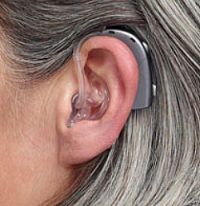
Advantages of BTE with ear mould:
- It can be fitted to all degrees of hearing loss, including PROFOUND HEARING LOSS
- It is available in models with wireless connectivity to devices and advanced technology
- The custom-fit ear mould can be replaced separately easily
- These are less susceptible to moisture and ear wax damage
Disadvantages of BTE with ear mould:
- The sensation of ear occlusion due to a large ear mould
- They are difficult to be used in patients who wear spectacles
- They are not cosmetically very acceptable to many patients
THANK YOU
MEDICAL ADVICE DISCLAIMER:
This blog including information, content, references, and opinions is for informational purposes only.
The Author does not provide any medical advice on this platform.
Viewing, accessing, or reading this blog does not establish any doctor-patient relationship.
The information provided in this blog does not replace the services and opinions of a qualified medical professional who examines you and then prescribes medicines.
And if you have any questions of medical nature, please refer to your doctor or the qualified medical personnel for evaluation and management at a clinic/hospital near you.
The content provided in this blog represents the Author’s own interpretation of research articles.
